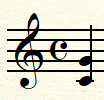LESSON 6
INTERVALS
* In music intervals are the distance between any two notes.
* There are two ways in which intervals are constructed, either harmonically or melodically. The construction of harmonic intervals are a note above the other's and the melodic intervals are one note after another.
* Intervals are made up of two parts the number and the quality. The numeric calculation of intervals begins with the letter name of the bottom note and it involves all of the other letters leading up to the top note, including the top note. For example, using C as a bottom note and G as the top note, the notes involved are C, D, E, F and G which includes 5 letters the numeric value is a 5th. The quality of these intervals can either be major, perfect, minor, diminished or augmented. To recognize the quality of a major interval, the top note of the interval must be belonging to the scale of the bottom note and it should be either a 2nd, 3rd, 6th or 7th degree. When a major interval is taken a semitone higher it becomes augmented and when it is taken a semitone lower it becomes minor and when a minor interval is taken a semitone lowes it becomes diminished. The quality of a perfect interval is also recognized when the top note belongs to the scale of the bottom note and it is either a 4th, 5th or 8th. degree. Whan a perfect interval is taken a semitone higher it becomes an augmented interval and when the perfect interval is taken a semitone lower it's a diminished interval.
* There are some simple ways for identifying intervals if the two notes are space-notes or line-notes it is an odd number but if the notes occupy line and space its an even number. In the C major scale, the notes next to each other's are major seconds' except for the 3rd and 4th, the 7th and 8th degree these are minor seconds. There are three major 3rd's and four minor 3rd's, the major 3rd's are the 1st and 3rd, 4th and 6th and the 5th and 7th degree. All of the other 3rds are minor 3rds. There are six perfect intervals and one augmented interval and the augmented interval is the 4th and 7th degree.
* There are also invert intervals, this is where the lower note moves up an octave. In this case, the total of the interval before and after it is inverted will add up to 9. The invert of a major interval becomes a minor interval and vice versa, a diminished interval becomes an augmented interval and vice versa, while a perfect interval remains the same.








Comments
Post a Comment